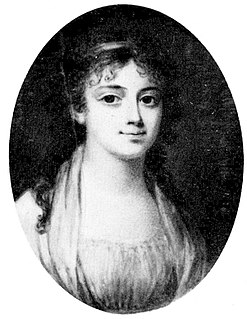Related Research Articles

Ulrika Eleonora of Denmark and Norway was Queen of Sweden as the wife of King Charles XI.

Emilie Sophie Högquist or Högqvist was a Swedish stage actress. She was a star of the Royal Dramatic Theatre and has been referred to as the first celebrity within Swedish drama and known as the Swedish Aspasia, both for her artistic ability but also for the literary salon she hosted. She is also known in history for her love affair with King Oscar I of Sweden.

Anna Sophia "Sophie" Hagman, néeAnna Kristina "Stina" Hagman, was a Swedish ballet dancer. She was the official royal mistress to Prince Frederick Adolf of Sweden from 1778 to 1793.

Fredrica Löf, also known as Fredrique Löwen, was a Swedish stage actress. She was the first female star at the newly founded national stage Royal Dramatic Theater, which was founded the year of her debut.

Anna Ulrica Arfvidsson (1734–1801) was a professional Swedish fortune-teller during the reign of Gustav III of Sweden. She was commonly known as Mamsell Arfvidsson.

Charlotte Slottsberg was a Swedish ballerina. She was one of the first native members of the Royal Swedish Ballet. She was also known as a courtesan and as the controversial mistress of the future Charles XIII of Sweden. She was the first native star of the Royal Swedish Ballet.
Inga Åberg was a Swedish actress and opera singer. She was engaged as an opera singer at the Royal Swedish Opera, and as a stage actress at the Royal Dramatic Theater, between 1787 and 1810.

Beata Charlotta "Charlotte" Eckerman, was a Swedish opera singer and actress. She was also a very well known courtesan during the Gustavian era, and the official royal mistress of Charles XIII of Sweden from 1779 to 1781.

Zelma Carolina Esolinda Hedin née Bergnéhr was a Swedish stage actress. She was an elite actress of the Royal Dramatic Theatre, where she belonged to the star actors in the mid 19th-century. She was also known as Zelma Bergnéhr, Zelma Kinmansson and Zelma Bergmansson.

Christina Augusta Löwenhielm née von Fersen, was a Swedish countess and courtier. She is known for her love affair with the later Charles XIII of Sweden. She is also famous in history as one of "the three graces" of the Gustavian age; three ladies-in-waiting immortalized in the poem Gracernas döpelse by Johan Henric Kellgren, and known profiles of the epoch.
Juliana of Hesse-Eschwege was a German noblewoman. In her teens she was brought up at the Swedish royal court as the future queen of King Charles XI of Sweden, her cousin. However, on two separate occasions before the wedding Juliana became pregnant, and the engagement was eventually broken off. In 1679 or 1680, Juliana married a Dutchman and lived the rest of her life in the Netherlands, while Charles married Ulrike Eleonora of Denmark in 1680.

Euphrosyne (Euphrosina) Löf was a Swedish ballet dancer and stage actress, best known for her affair with Prince Frederick Adolf of Sweden from 1795 to 1800, after his relationship with Sophie Hagman. Euphrosyne Löf acted as his hostess at Tullgarn.
Josephine Sophie Anette Charlotte Sparre af Söfdeborg, called Jossan or Schossan, was a Swedish noble, lady-in-waiting and a royal mistress to King Charles XV of Sweden.
Lovisa "Louise" Augusta Meijerfeldtnée Sparre af Sundby, was a Swedish noble and courtier. She is famous in history as one of "the three graces" of the Gustavian age; three ladies-in-waiting immortalized in the poem Gracernas döpelse by Johan Henric Kellgren, and known profiles of the epoch.
Caroline Lewenhaupt (1754–1826) was a Swedish courtier, poet and amateur actress.

Amelie "Malla" Höök (1811–1882) was a Swedish actress and courtesan. She was engaged at the Royal Dramatic Theatre in Stockholm in 1828–1842, and also a well known courtesan. She is often mentioned in theater history for her friendship with Emilie Högqvist.
Carolina Brunström was a Swedish ballerina. She was considered as one of the leading members of the Royal Swedish Ballet in the 1810s and 1820s.
Hedvig Wilhelmina Augusta Sofia Maria Teresia Lovisa von Fersen was a Swedish countess and heiress, and the last member of the von Fersen family. She was one of the greatest heirs of 19th-century Sweden and became notorious for the scandal of her and her husband's great bankruptcy, having wasted a fortune of about eight million riksdaler on an expensive lifestyle and gambling.
Matilda Kristina von Schwerin née Hagberg was a Swedish countess and landowner. She was a central figure in two great scandals in 19th-century Sweden; when her future husband's brother sued him for his intending marriage to her on accusations of incest (1841–44) and when her late husband's brother refused to acknowledge her legal right to her inheritance and dower land after her late spouse (1849–56), known in history as the 'Schwerin Estate's Scandals'.

Gustaf Elis Fischer was a Swedish lawyer, chief executive of Skandia and politician who was Member of Parliament. He is in particular known for the Fischer-trial, in which he was accused of fraud and sentenced to prison.
References
- Svenska millionärer. Minnen och anteckningar / 1
- https://www.adelsvapen.com/genealogi/Liljenstolpe_nr_2151
- Nordensvan, Georg, Svensk teater och svenska skådespelare från Gustav III till våra dagar. Andra delen, 1842–1918, Bonnier, Stockholm, 1918